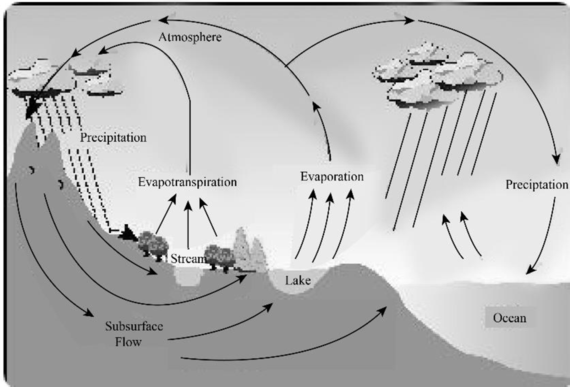
The explanation of the movement of the water in the hydrologic cycle.
Answer to Problem 1QFR
The movement of the water takes place in the five stages in the hydrologic cycle.
* Evaporation
* Condensation
* Precipitation
* Transpiration
* Sublimation
Explanation of Solution

Figure-(1)
The figure above represents the Hydrological cycle.
The stages of the movement of the water in the hydrologic cycle are as follows:
* Evaporation: Evaporation is the process in which the liquid particles turns into the vapor form.
* Condensation: Condensation is the process in which the vapor form gets converted into the liquid form.
* Precipitation: Precipitation is the process in which the water droplets formed in the atmosphere falls to the surface of the Earth under the action of gravity.
* Transpiration: The process of the removal of the water in the form of the vapors is known as transpiration.
* Sublimation: Sublimation is the process in which the conversion of the solid form to the gaseous form takes place.
Want to see more full solutions like this?
Chapter 4 Solutions
ESSENTIALS OF METEOROLOGY
- N (120') -1180- (120') (105') 0 50 100 feet 1160- -1140- A (100') B (90') (80) Proposed well -1120. (95) (80°) (80') 1100 Well location (Depth to top of water table) A Figure 8.14 Hypothetical topographic map showing the locations of several water wells. The numbers in parentheses indicate the depth of the water table below the surface in each well.arrow_forwardDue tomorrow 3/27 2 pm if you could give me detailed solutions pleasearrow_forwardDue 3/27 at 2pmarrow_forward
- Based on the Climate-Change Censorship campaign article (WSJ) does the phenomenon of scientific certainty ever exist? Why or why not?arrow_forwardBased on the Climate-Change Censorship campaign article (WSJ) some think that twitter, snapchat, instagram, facebook, google, messenger, et al. are the new forums for public discourse. Should the big tech company owners of these sites be allowed to censor the information and comments posted by the public?arrow_forwardHow does radon enter a home?arrow_forward
 Applications and Investigations in Earth Science ...Earth ScienceISBN:9780134746241Author:Edward J. Tarbuck, Frederick K. Lutgens, Dennis G. TasaPublisher:PEARSON
Applications and Investigations in Earth Science ...Earth ScienceISBN:9780134746241Author:Edward J. Tarbuck, Frederick K. Lutgens, Dennis G. TasaPublisher:PEARSON Exercises for Weather & Climate (9th Edition)Earth ScienceISBN:9780134041360Author:Greg CarbonePublisher:PEARSON
Exercises for Weather & Climate (9th Edition)Earth ScienceISBN:9780134041360Author:Greg CarbonePublisher:PEARSON Environmental ScienceEarth ScienceISBN:9781260153125Author:William P Cunningham Prof., Mary Ann Cunningham ProfessorPublisher:McGraw-Hill Education
Environmental ScienceEarth ScienceISBN:9781260153125Author:William P Cunningham Prof., Mary Ann Cunningham ProfessorPublisher:McGraw-Hill Education Earth Science (15th Edition)Earth ScienceISBN:9780134543536Author:Edward J. Tarbuck, Frederick K. Lutgens, Dennis G. TasaPublisher:PEARSON
Earth Science (15th Edition)Earth ScienceISBN:9780134543536Author:Edward J. Tarbuck, Frederick K. Lutgens, Dennis G. TasaPublisher:PEARSON Environmental Science (MindTap Course List)Earth ScienceISBN:9781337569613Author:G. Tyler Miller, Scott SpoolmanPublisher:Cengage Learning
Environmental Science (MindTap Course List)Earth ScienceISBN:9781337569613Author:G. Tyler Miller, Scott SpoolmanPublisher:Cengage Learning Physical GeologyEarth ScienceISBN:9781259916823Author:Plummer, Charles C., CARLSON, Diane H., Hammersley, LisaPublisher:Mcgraw-hill Education,
Physical GeologyEarth ScienceISBN:9781259916823Author:Plummer, Charles C., CARLSON, Diane H., Hammersley, LisaPublisher:Mcgraw-hill Education,





